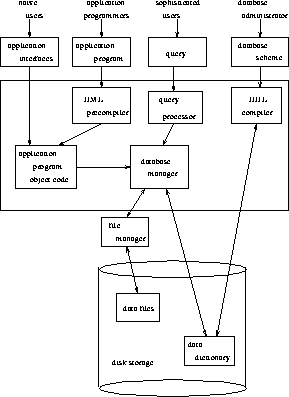- File manager manages allocation of disk space and data structures used to represent information on disk.
- Database manager:
The interface between low-level data and application programs and queries.
- Query processor
translates statements in a query language into low-level instructions
the database manager understands.
(May also attempt to find an equivalent but more efficient form.)
- DML precompiler converts DML statements embedded in an application program to normal procedure calls in a host language. The precompiler interacts with the query processor.
- DDL compiler converts DDL statements to a set of tables containing metadata stored in a data dictionary.
- Data files: store the database itself.
- Data dictionary: stores information about the structure of the
database.
It is used heavily.
Great emphasis should be placed on developing a good design and efficient
implementation of the dictionary.
- Indices: provide fast access to data items holding particular values.

Figure 1.6: Database system structure.


